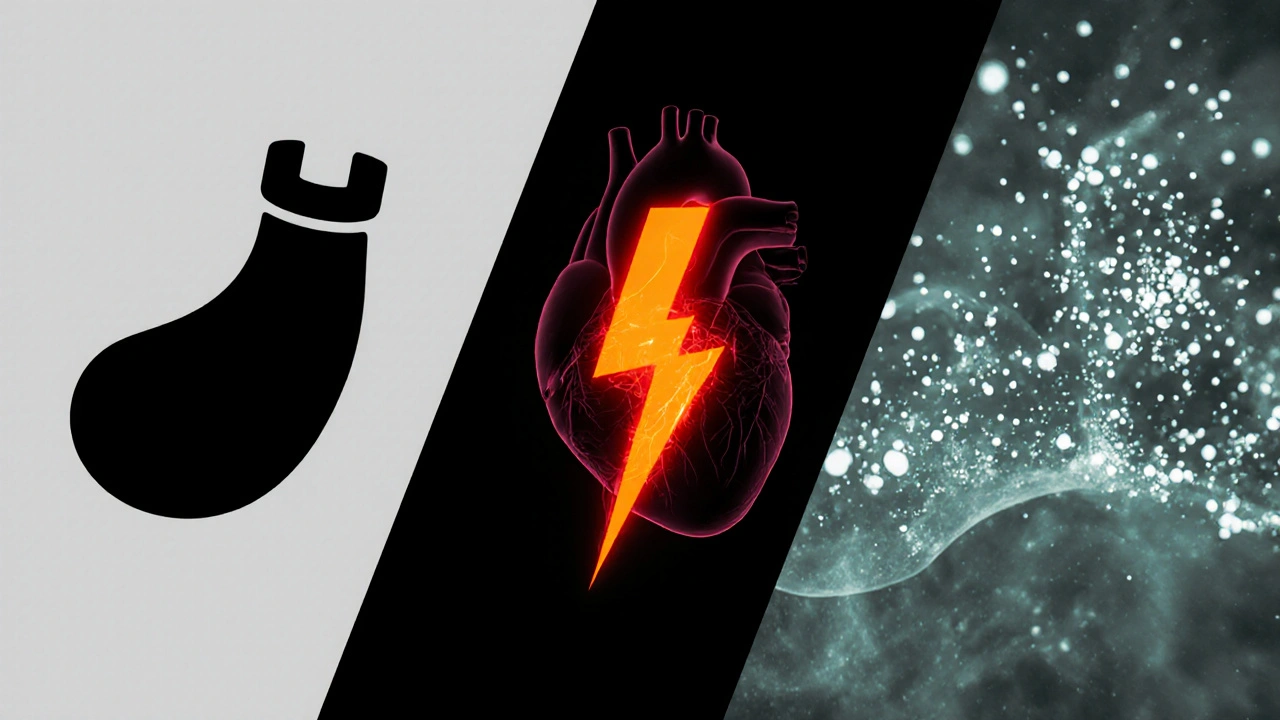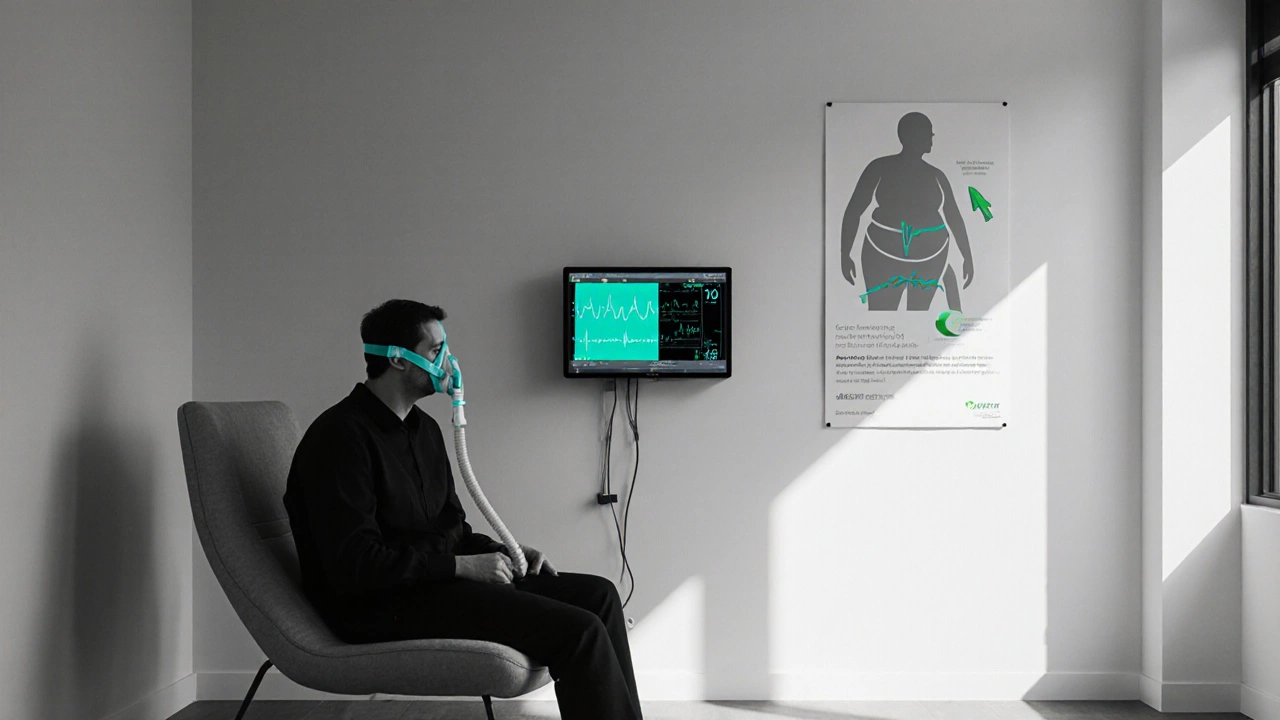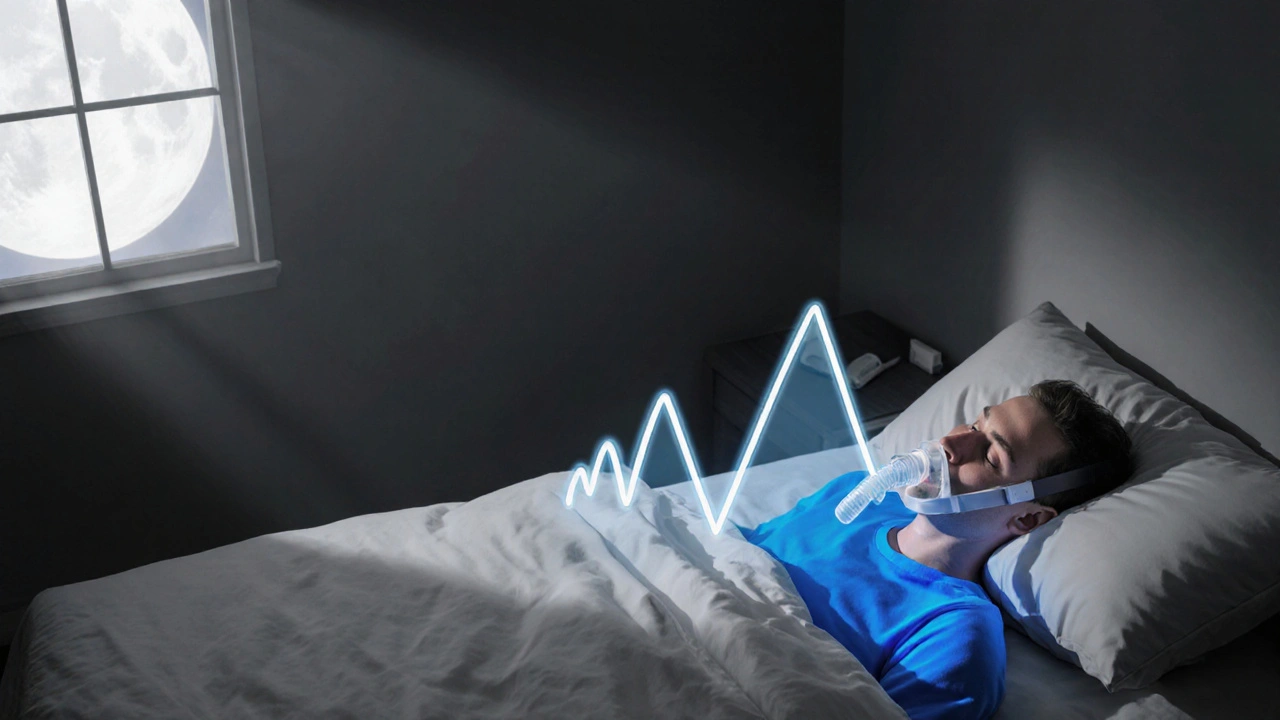Weight Loss Impact Calculator
Your Weight Loss Goal
Your Results
Estimated Benefits
AHI Reduction
50%
AF Recurrence Risk
40% Decrease
Key Fact Per the Sleep Heart Health Study: 10% weight loss can cut OSA severity by up to 50% and reduce AF risk significantly.
Why This Matters
The article states: "A 10% drop in body weight can cut the apnea-hypopnea index by up to 50% and shrink atrial size, lowering the substrate for AF."
5-15%
Oxygen drop during apnea
30%
AF recurrence reduction with CPAP
2.2x
Increased AF risk with moderate OSA
Ever wonder why a bad night’s sleep can leave your heart racing? The relationship between sleep apnea and atrial fibrillation (AF) is more than coincidence - it’s a two‑way street where breathing problems can trigger irregular heartbeats, and a chaotic heart rhythm can worsen sleep quality. Below you’ll find what ties these conditions together, how doctors figure it out, and what you can do to break the cycle.
Quick Takeaways
- Sleep apnea triples the odds of developing atrial fibrillation, especially in people over 50.
- Intermittent oxygen drops and spikes in sympathetic activity are the main culprits.
- CPAP therapy can cut AF recurrence by up to 40% in clinical trials.
- Common risk factors - obesity, hypertension, and alcohol - fuel both disorders.
- Screening for one condition should automatically trigger evaluation for the other.
What Is Sleep Apnea?
Sleep Apnea is a sleep‑related breathing disorder where breathing repeatedly stops and starts during sleep. It affects roughly 22million adults in the United States, and prevalence climbs to 40% among people with obesity.
The two main forms are:
- Obstructive Sleep Apnea (OSA): The airway collapses, usually because of excess tissue around the neck.
- Central Sleep Apnea (CSA): The brain fails to send proper signals to the breathing muscles.
Both lead to brief periods of low oxygen (hypoxia) followed by a surge of carbon dioxide, snapping the body awake for a few seconds.
What Is Atrial Fibrillation?
Atrial Fibrillation is a cardiac arrhythmia where the upper chambers (atria) beat irregularly and rapidly, causing a chaotic heart rhythm. In the U.S., about 6million adults live with AF, and the number is expected to rise as the population ages.
AF can be paroxysmal (comes and goes), persistent (lasts longer than a week), or permanent (cannot be restored to normal rhythm). The condition increases stroke risk five‑fold and doubles the chance of heart failure.
How Sleep Apnea Fuels Atrial Fibrillation
Three physiological pathways link the two disorders:
| Mechanism | What Happens During Apnea | Effect on the Heart |
|---|---|---|
| Intermittent Hypoxia | Oxygen saturation drops 5-15% | Promotes electrical remodeling, making atria more prone to fibrillation |
| Sympathetic Surge | Heart rate spikes 10-30bpm after each apnea episode | Increases atrial pressure and triggers ectopic beats |
| Inflammation & Oxidative Stress | Elevated CRP, IL‑6, and reactive oxygen species | Leads to structural remodeling (fibrosis) of atrial tissue |
These changes don’t happen overnight. Long‑term exposure-think years of untreated OSA-creates a substrate where AF can start and stick around.

Shared Risk Factors
If you already have one condition, you’re more likely to develop the other because they share the same “danger zone.”
- Obesity: Excess fat around the neck narrows the airway; it also raises blood volume, stressing the heart.
- Hypertension: High blood pressure stiffens atrial walls, making them less able to handle pressure swings from apnea.
- Age: Both OSA and AF prevalence jump after 50.
- Alcohol & Sedatives: Relax throat muscles and increase atrial irritability.
- Diabetes: Contributes to autonomic dysfunction and vascular inflammation.
What the Research Says
A landmark 2023 Sleep Heart Health Study followed 5,200 participants for a median of 9years. Those with moderate‑to‑severe OSA (AHI≥15 events/hour) had a 2.2‑fold higher incidence of new‑onset AF after adjusting for age, BMI, and hypertension.
Another randomized trial (CAN‑AF, 2024) enrolled 300 patients with paroxysmal AF and OSA. Participants who used CPAP >4hours/night experienced 38% fewer AF recurrences over 12months compared with a control group receiving sham CPAP.
Meta‑analyses across ten studies (total n≈12,000) consistently report a relative risk between 1.8 and 3.0 for AF in untreated OSA patients. The take‑away? Treating the breathing problem pays off in heart rhythm stability.
Screening and Diagnosis
Because the link is strong, many cardiology societies now recommend routine sleep apnea screening for anyone with AF. Here’s a practical flow:
- Ask patients about snoring, witnessed apneas, or daytime sleepiness (Epworth score≥10).
- If the questionnaire is positive, order a home sleep apnea test (HSAT) or full polysomnography.
- When AF is diagnosed, review the sleep study results and consider a nocturnal ECG strip to catch nocturnal arrhythmias.
- For patients with known OSA, schedule a routine ECG or Holter monitor to watch for AF onset.
Tools like the WatchPAT or portable oximeter make screening feasible in primary‑care settings.
Treatment Strategies That Hit Both Targets
Addressing sleep apnea can dramatically lower AF burden. The main interventions are:
- CPAP Therapy: Keeps the airway open, normalizing oxygen levels and dampening sympathetic spikes. Studies show a 30‑40% reduction in AF recurrence after catheter ablation.
- Weight Management: Losing 5-10% of body weight can drop the apnea‑hypopnea index (AHI) by half and improve atrial size.
- Positional Therapy: Sleeping on the side reduces OSA severity for many patients.
- Alcohol Moderation: Limiting intake after 6p.m. curbs both apnea events and atrial ectopy.
- Blood Pressure Control: ACE inhibitors or ARBs lessen atrial stretch and improve CPAP tolerance.
When AF is already present, rhythm‑control strategies (anti‑arrhythmic drugs or catheter ablation) work best when combined with effective OSA treatment. Ignoring the sleep disorder often leads to AF “recurrence” after a successful ablation.

Practical Checklist for Patients
- Ask your doctor about a sleep study if you snore loudly, wake up gasping, or feel fatigued.
- Track CPAP usage - aim for at least 4hours/night.
- Monitor blood pressure weekly; uncontrolled hypertension worsens both conditions.
- Maintain a sleep‑friendly environment: cool room, dark curtains, no screens after 9p.m.
- Log any palpitations, especially after a night of poor sleep, and share them with your cardiologist.
When to Seek Immediate Help
If you experience sudden chest pain, severe shortness of breath, or a rapid heart rate (150+bpm) that doesn’t settle, call emergency services. These can be signs of a dangerous AF episode or a severe apnea‑related cardiac event.
Future Directions
Researchers are now testing adaptive servo‑ventilation (ASV) devices that adjust pressure in real‑time based on heart rhythm feedback. Early data suggest a synergistic drop in both AHI and AF burden, but larger trials are needed.
Artificial‑intelligence algorithms that analyze home oximetry and ECG data together may soon flag patients at highest risk, prompting early intervention.
Frequently Asked Questions
Can treating sleep apnea cure atrial fibrillation?
Treating sleep apnea-especially with consistent CPAP use-significantly lowers the chance of AF returning, but it rarely “cures” the arrhythmia on its own. Most patients benefit from a combined approach that also addresses blood pressure, weight, and rhythm‑control meds or procedures.
How long does it take to see heart‑rate improvements after starting CPAP?
Most patients notice a reduction in nighttime heart‑rate spikes within the first few weeks. Full benefits for AF burden often appear after 3-6months of regular CPAP use.
Is a home sleep test enough for diagnosing OSA when I have atrial fibrillation?
A home sleep apnea test is acceptable for most moderate‑to‑severe cases and is often preferred for convenience. However, if you have complex heart rhythm issues, a full polysomnography can capture detailed ECG data alongside breathing patterns.
Does weight loss really affect both conditions?
Yes. A 10% drop in body weight can cut the apnea‑hypopnea index by up to 50% and shrink atrial size, lowering the substrate for AF.
Should I avoid alcohol if I have both sleep apnea and AF?
Limiting alcohol, especially in the evening, is advisable. Alcohol relaxes airway muscles and can trigger atrial ectopy, worsening both conditions.
